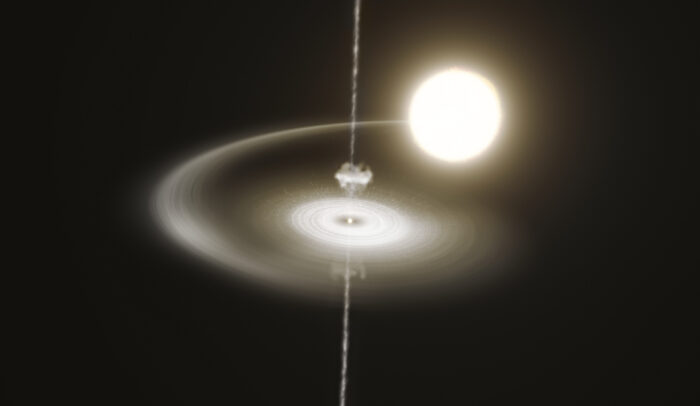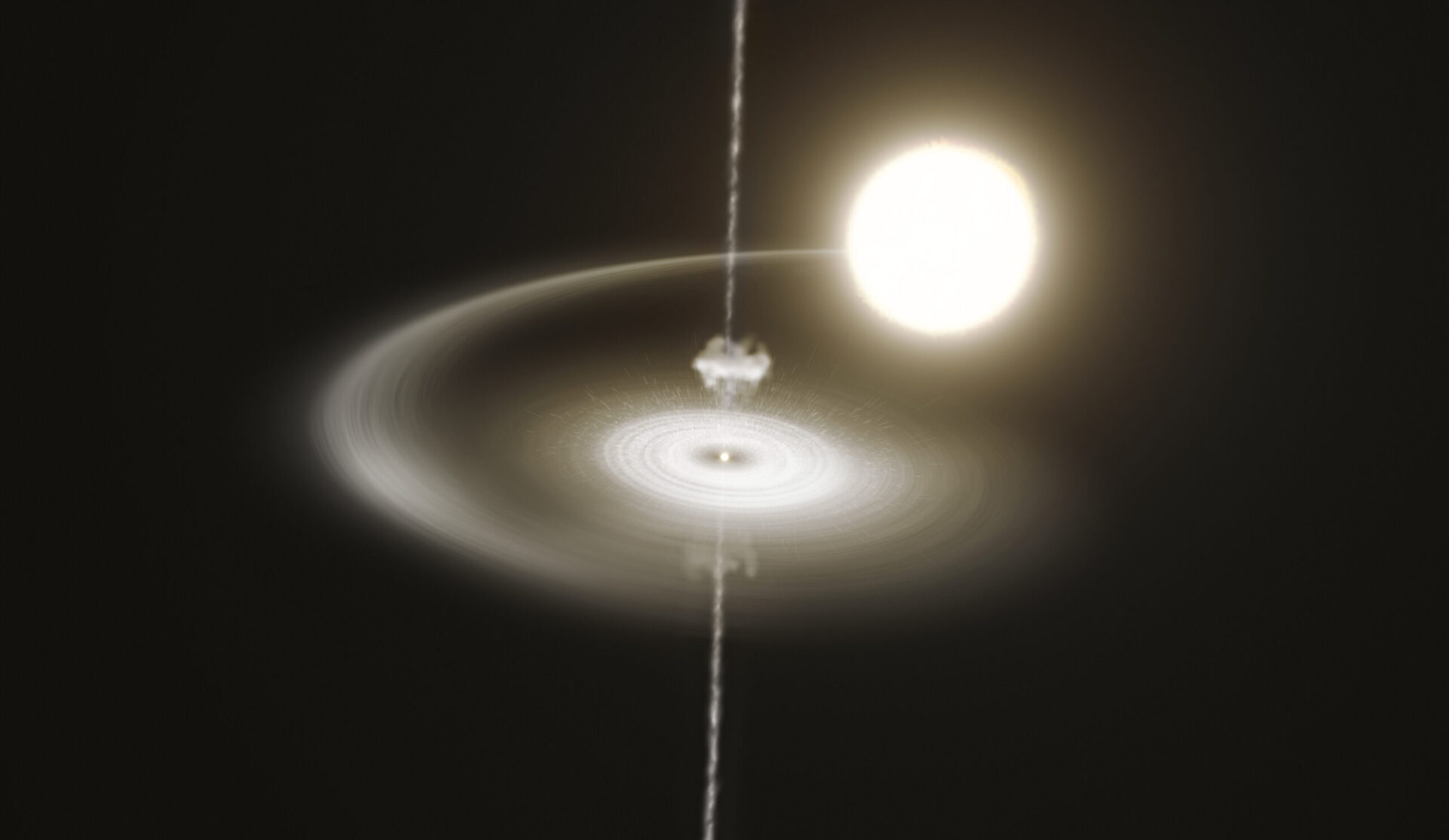ALMA and Other Telescopes Help Unravel Pulsar Puzzle
With a remarkable observational campaign that involved 12 telescopes both on the ground and in space, including the Atacama Large Millimeter/submillimeter Array (ALMA), astronomers have uncovered the strange behavior of a pulsar, a super-fast-spinning dead star. This mysterious object is known to switch between two brightness modes almost constantly, which has been an enigma until now. However, astronomers have found that sudden ejections of matter from the pulsar over very short periods are responsible for the peculiar switches.
"We have witnessed extraordinary cosmic events where enormous amounts of matter, similar to cosmic cannonballs, are launched into space within a very brief time span of tens of seconds from a small, dense celestial object rotating at incredibly high speeds," says Maria Cristina Baglio, researcher at New York University Abu Dhabi, affiliated with the Italian National Institute for Astrophysics (INAF), and the lead author of the paper published today in Astronomy & Astrophysics.
A pulsar is a fast-rotating, magnetic, dead star that emits a beam of electromagnetic radiation into space. As it rotates, this beam sweeps across the cosmos — much like a lighthouse beam scanning its surroundings — and is detected by astronomers as it intersects the line of sight to Earth. This makes the star appear to pulse in brightness as seen from our planet.
PSR J1023+0038, or J1023 for short, is a particular type of pulsar with bizarre behavior. It is located about 4500 light-years away in the Sextans constellation and closely orbits another star. Over the past decade, the pulsar has been actively pulling matter off this companion, which accumulates in a disc around the pulsar and slowly falls towards it.
Since this process of accumulating matter began, the sweeping beam virtually vanished, and the pulsar started incessantly switching between two modes. In the 'high' mode, the pulsar gives off bright X-rays, ultraviolet, and visible light, while in the 'low' mode, it's dimmer at these frequencies and emits more radio waves. The pulsar can stay in each mode for several seconds or minutes and then switch to the other mode in just a few seconds. This switching has thus far puzzled astronomers.
"Our unprecedented observing campaign to understand this pulsar's behavior involved a dozen cutting-edge ground-based and space-borne telescopes," says Francesco Coti Zelati, a researcher at the Institute of Space Sciences, Barcelona, Spain, and co-lead author of the paper. The campaign included ALMA as well as three other telescopes from its partners: European Southern Observatory’s (ESO) Very Large Telescope (VLT) and New Technology Telescope (NTT), which detected visible and near-infrared light; and National Radio Astronomy Observatory’s (NRAO) VLA, which caught longer radiowaves than ALMA. Over two nights in June 2021, they observed the system make over 280 switches between its high and low modes.
"We have discovered that the mode switching stems from an intricate interplay between the pulsar wind, a flow of high-energy particles blowing away from the pulsar, and matter flowing towards the pulsar," says Coti Zelati, who is also affiliated with INAF.
In the low mode, matter flowing towards the pulsar is expelled in a narrow jet perpendicular to the disc. Gradually, this matter accumulates closer and closer to the pulsar, and, as this happens, it is hit by the wind blowing from the pulsating star, causing the matter to heat up. The system is now in a high mode, glowing brightly in the X-ray, ultraviolet, and visible light. Eventually, blobs of this hot matter are removed by the pulsar via the jet. With less hot matter in the disc, the system glows less brightly, switching back into the low mode.
While this discovery has unlocked the mystery of J1023's strange behavior, astronomers still have much to learn from studying this unique system. New telescopes will continue to help astronomers observe this peculiar pulsar. In particular, ESO's Extremely Large Telescope (ELT), currently under construction in Chile, will offer an unprecedented view of J1023's switching mechanisms. "The ELT will allow us to gain key insights into how the abundance, distribution, dynamics, and energetics of the inflowing matter around the pulsar are affected by the mode switching behavior," concludes Sergio Campana, Research Director at the INAF Brera Observatory and coauthor of the study.
Additional Information
This research was presented in a paper to appear in Astronomy & Astrophysics(doi:10.1051/0004-6361/202346418)
The team is composed of M. C. Baglio (Center for Astro, Particle, and Planetary Physics, New York University Abu Dhabi, UAE [NYU Abu Dhabi]; INAF – Osservatorio Astronomico di Brera, Merate, Italy [INAF Brera]), F. Coti Zelati (Institute of Space Sciences, Campus UAB, Barcelona, Spain [ICE–CSIC]; Institut d’Estudis Espacials de Catalunya (IEEC), Barcelona, Spain [IEEC]; INAF Brera), S. Campana (INAF Brera), G. Busquet (Departament de Física Quànticai Astrofísica, Universitat de Barcelona, Spain; Institut de Ciències del Cosmos, Universitat de Barcelona, Spain; IEEC), P. D’Avanzo (INAF Brera), S. Giarratana (INAF – Istituto di Radioastronomia, Bologna, Italy [INAF Bologna]; Department of Physics and Astronomy, University of Bologna, Italy [Bologna]), M. Giroletti (INAF Bologna; Bologna), F. Ambrosino (INAF – Osservatorio Astronomico di Roma, Rome, Italy [INAF Roma]); INAF – Istituto Astrofisica Planetologia Spaziali, Rome, Italy; Sapienza Università di Roma, Rome, Italy), S.Crespi (NYU Abu Dhabi), A. Miraval Zanon (Agenzia Spaziale Italiana, Rome, Italy; INAF Roma), X. Hou (Yunnan Observatories, Chinese Academy of Sciences, Kunming, China; Key Laboratory for the Structure and Evolution of Celestial Objects, Chinese Academy of Sciences, Kunming, China), D. Li (National Astronomical Observatories, Chinese Academy of Sciences, Beijing, China; University of Chinese Academy of Sciences, Beijing, China; Research Center for Intelligent Computing Platforms, Zhejiang Laboratory, Hangzhou, China), J. Li (CAS Key Laboratory for Research in Galaxies and Cosmology, Department of Astronomy, University of Science and Technology of China, Hefei, China; School of Astronomy and Space Science, University of Science and Technology of China, Hefei, China), P. Wang (Institute for Frontiers in Astronomy and Astrophysics, Beijing Normal University, Beijing, China), D. M. Russell (NYU Abu Dhabi), D. F. Torres (INAF Brera; IEEC; Institució Catalana de Recercai Estudis Avançats, Barcelona, Spain), K. Alabarta (NYU Abu Dhabi), P. Casella (INAF Roma), S. Covino (INAF Brera), D. M. Bramich (NYU Abu Dhabi; Division of Engineering, New York University Abu Dhabi, UAE), D. de Martino (INAF − Osservatorio Astronomico di Capodimonte, Napoli, Italy), M. Méndez (Kapteyn Astronomical Institute, University of Groningen, Groningen, The Netherlands), S. E. Motta (INAF Brera), A. Papitto (INAF Roma), P. Saikia (NYU Abu Dhabi), and F. Vincentelli (Instituto de Astrofísica de Canarias, Tenerife, Spain; Departamento de Astrofísica, Universidad de La Laguna, Tenerife, Spain).
The European Southern Observatory (ESO), the ALMA partner on behalf of Europe, published the original press release.
The Atacama Large Millimeter/submillimeter Array (ALMA), an international astronomy facility, is a partnership of ESO, the U.S. National Science Foundation (NSF), and the National Institutes of Natural Sciences (NINS) of Japan in cooperation with the Republic of Chile. ALMA is funded by ESO on behalf of its Member States, by NSF in cooperation with the National Research Council of Canada (NRC) and the National Science and Technology Council (NSTC) in Taiwan, and by NINS in cooperation with the Academia Sinica (AS) in Taiwan and the Korea Astronomy and Space Science Institute (KASI).
ALMA construction and operations are led by ESO on behalf of its Member States; by the National Radio Astronomy Observatory (NRAO), managed by Associated Universities, Inc. (AUI), on behalf of North America; and by the National Astronomical Observatory of Japan (NAOJ) on behalf of East Asia. The Joint ALMA Observatory (JAO) provides the unified leadership and management of the construction, commissioning, and operation of ALMA.
Image

Animation
Contacts
-
Nicolás Lira
Education and Public Outreach CoordinatorJoint ALMA Observatory, Santiago - ChilePhone: +56 2 2467 6519Cel: +56 9 9445 7726Email: [email protected] -
Bárbara Ferreira
ESO Media Manager -
Jill Malusky
Public Information Officer -
Naoko Inoue
EPO officer, ALMA ProjectNational Astronomical Observatory of Japan (NAOJ)Email: [email protected]

